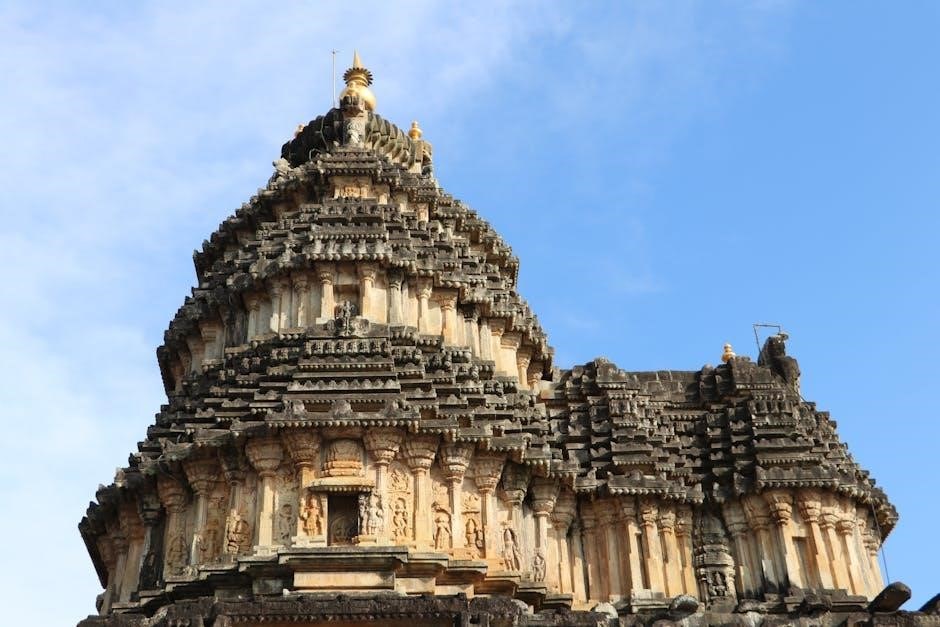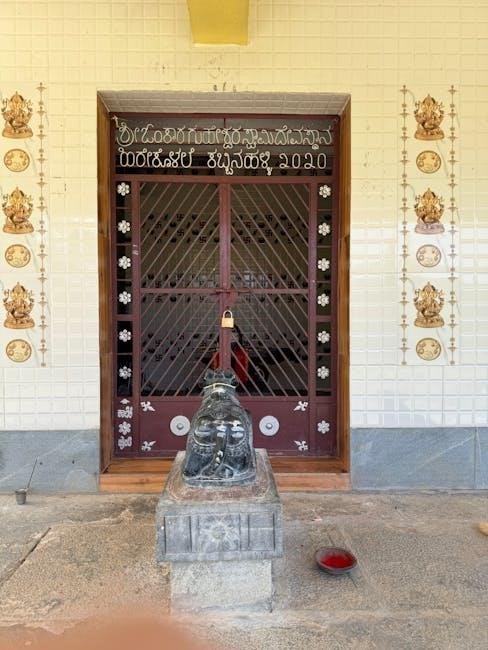Lalitha Sahasranama is a revered Hindu scriptural text, a hymn dedicated to Goddess Lalitha, an incarnation of Durga. It is part of the Brahmanda Purana and contains 1000 names extolling her virtues, emphasizing her cosmic significance and spiritual power. This sacred text is widely recited in Shaktism, a tradition worshipping the divine feminine, and is believed to offer profound spiritual growth and fulfillment. Its availability in Kannada PDF format has made it accessible to millions, fostering devotion and cultural connection across generations.
1.1 Overview of Lalitha Sahasranama
Lalitha Sahasranama, or the “Thousand Names of Lalita,” is a revered Hindu hymn dedicated to Goddess Lalita, a form of Goddess Durga. It is part of the Brahmanda Purana and consists of 1000 names that describe the divine attributes, powers, and graciousness of the Goddess. Each name is a mantra, encapsulating spiritual, philosophical, and devotional significance. The hymn is structured as a dialogue between the sage Agastya and the god Hayagriva, highlighting its sacred origin. Lalitha Sahasranama is not just a devotional text but also a philosophical treatise, reflecting the essence of Shaktism, which worships the feminine principle as the supreme power. Its recitation is believed to confer spiritual enlightenment, protection, and fulfillment of desires.
The Kannada version of Lalitha Sahasranama has made this sacred text accessible to millions of devotees in Karnataka and other Kannada-speaking regions. It preserves the original meaning while adapting to the cultural and linguistic nuances of the region. This adaptation has played a significant role in spreading the reverence for Goddess Lalita and fostering a deeper connection among devotees.
The text is often recited in temples, homes, and during special rituals, emphasizing its cultural and spiritual importance. Its availability in Kannada ensures that the divine message of Lalitha Sahasranama reaches a broader audience, transcending linguistic barriers and strengthening the bond between devotees and the divine feminine energy.
1.2 Importance in Hindu Scripture
Lalitha Sahasranama holds a revered position in Hindu scripture, particularly within the Shaktism tradition, which venerates the divine feminine energy. It is considered one of the most sacred hymns dedicated to Goddess Lalita, a manifestation of Goddess Durga. The text is part of the Brahmanda Purana and is widely regarded for its spiritual depth and philosophical insights. Its significance lies in its ability to connect devotees with the divine feminine, offering a pathway to spiritual enlightenment and self-realization. Recitation of the Sahasranama is believed to bestow blessings, protection, and fulfillment of desires, making it a cornerstone of Hindu devotional practices. Its inclusion in Kannada ensures its teachings reach a wider audience, preserving its cultural and religious importance in Karnataka and beyond.

Significance of Lalitha Sahasranama
Lalitha Sahasranama is a sacred hymn in Hinduism, especially revered in Shaktism, embodying spiritual growth and divine connection. Its Kannada version enhances accessibility and cultural preservation.
2.1 Spiritual and Religious Significance
Lalitha Sahasranama holds profound spiritual and religious significance as a reverence to Goddess Lalitha, embodying divine feminine power. It is a cornerstone in Shaktism, guiding devotees toward spiritual enlightenment and self-realization. The hymn’s 1,000 names symbolize the infinite attributes of the Divine Mother, offering a deep meditative experience. Reciting it in Kannada fosters a connection to regional culture while preserving its universal spiritual essence. It is believed to bring inner peace, dispel negativity, and grant blessings. The text is often recited in rituals and pujas, serving as a powerful tool for devotion and spiritual growth.
2.2 Cultural and Historical Context
Lalitha Sahasranama is deeply rooted in the cultural and historical fabric of South India, particularly in Karnataka, where the Kannada version is widely revered. This sacred hymn, composed by sage Agastya, reflects the rich spiritual heritage of the region. It has been passed down through generations, influencing art, literature, and festivals. The text embodies the devotion to the Divine Mother, a central theme in Hindu culture. Its translation into Kannada has made it accessible to a broader audience, preserving its cultural significance. Historically, it has played a pivotal role in shaping the spiritual identity of the region, with its recitation being an integral part of traditional practices and community celebrations.
2.3 Role in Shaktism
Lalitha Sahasranama holds a central position in Shaktism, a tradition that venerates the Divine Mother as the ultimate reality. It is considered a powerful tool for worship, meditation, and spiritual growth. The text is often recited in Shakti temples and during rituals, serving as a means to invoke the blessings of the Divine Mother. In Shaktism, Lalitha Sahasranama is believed to embody the essence of feminine divine energy, or Shakti, and is used to attain spiritual liberation and self-realization. Its Kannada version has further popularized its reach, making it accessible to devotees in Karnataka and beyond. It remains a foundational text for Shaktas, guiding them in their devotion and spiritual practices.

Structure and Composition
Lalitha Sahasranama is a revered hymn structured into verses and phalasruti, comprising sacred names of the Divine Mother. Its composition in Kannada preserves the original essence, ensuring accessibility and spiritual connection for devotees.
3.1 Origin and Source
Lalitha Sahasranama originates from the Brahmanda Purana, a sacred Hindu scripture. It is a hymn dedicated to Goddess Lalita Tripurasundari, describing her divine attributes and cosmic form. The text was composed by the sage Agastya and the deity Hayagriva, emphasizing its spiritual authenticity. In Kannada, the PDF versions faithfully translate this ancient Sanskrit hymn, preserving its spiritual essence. The source of the text is deeply rooted in Hindu mythology and Shaktism, making it a cornerstone of devotion for followers. Its availability in Kannada ensures accessibility for regional devotees, bridging the gap between ancient wisdom and modern accessibility while maintaining its sacred origins.
3.2 Division into Sections
Lalitha Sahasranama is structured into distinct sections, enhancing its recitation and comprehension. The text begins with prayers to Ganesha and others, followed by the Namavali, which lists divine names. The main Sahasranama is divided into 185 verses, each extolling Goddess Lalita’s virtues. In Kannada PDFs, these sections are clearly delineated, aiding devotees in systematic recitation. The structure includes introductory hymns, the core 1000 names, and concluding prayers like the Phala Shruti, which details benefits. This division ensures a balanced blend of devotion and spirituality, making it accessible for both seasoned practitioners and newcomers seeking guidance.
3.4 Language and Style
Lalitha Sahasranama in Kannada retains the spiritual essence of the original Sanskrit text while adapting to the linguistic nuances of Kannada. The language is simple yet profound, making it accessible to devotees across all educational backgrounds. The style maintains the poetic and rhythmic structure of the original, with each verse (shloka) carefully translated to preserve meaning and meter. Kannada PDF versions often include diacritical marks to aid pronunciation, ensuring authenticity. The text’s devotional tone remains intact, blending philosophical depth with emotional appeal. This linguistic adaptation ensures that the sacred hymn resonates deeply with Kannada-speaking devotees, facilitating spiritual connection and ease of recitation.

Lalitha Sahasranama in Kannada
Lalitha Sahasranama in Kannada is widely revered and easily accessible in various formats, catering to devotees seeking spiritual connection through the Kannada language across Karnataka and other regions.
4.1 Translation and Adaptation
The Lalitha Sahasranama has been meticulously translated and adapted into Kannada, preserving its spiritual essence while ensuring accessibility for Kannada-speaking devotees. Renowned scholars and translators have contributed to its accurate rendition, maintaining the hymn’s poetic and philosophical depth. The adaptation process involved careful consideration of cultural nuances, ensuring the sacred text resonates deeply with local traditions. This translation has played a pivotal role in spreading the teachings of Shaktism across Karnataka and beyond, making it a cherished resource for spiritual seekers. The Kannada version is widely appreciated for its clarity and faithfulness to the original Sanskrit text, facilitating meaningful recitation and contemplation.
4.2 Availability of PDF Versions
The Lalitha Sahasranama in Kannada is widely available in PDF format, catering to the growing demand for digital accessibility. Numerous religious and cultural websites offer free downloads, while e-book platforms like Google Play Books and Amazon Kindle also host versions for easy access. Many temples and spiritual organizations provide downloadable PDFs on their official websites, ensuring authenticity and convenience. Additionally, apps dedicated to Hindu scriptures often include the Kannada version of Lalitha Sahasranama for offline reading. The availability of these PDFs has made it easier for devotees to recite and study the text without relying on physical copies. This digital accessibility has significantly contributed to its popularity and reach in the modern era.
4.3 Popular Translators and Commentators
The Lalitha Sahasranama in Kannada has been interpreted and translated by several esteemed scholars and spiritual leaders. Prominent translators include Adya Shankaracharya, whose Sanskrit commentary is widely revered, and modern scholars who have adapted the text into Kannada. Renowned commentators like Sri Jayatirtha and Sri Vadiraja Tirtha have also contributed insightful explanations, making the text more accessible. Their interpretations are often included in PDF versions, providing deeper understanding. These translators and commentators have played a crucial role in preserving and popularizing the text in Kannada, ensuring its spiritual and cultural relevance persists. Their work remains invaluable for devotees seeking guidance and enlightenment through Lalitha Sahasranama.

Benefits of Reciting Lalitha Sahasranama
Reciting Lalitha Sahasranama enhances spiritual growth, fosters mental peace, and attracts positive energy, benefiting devotees in their journey towards enlightenment and harmony.
5.1 Spiritual Benefits
Reciting Lalitha Sahasranama fosters deep spiritual growth by connecting devotees with the divine feminine energy of Goddess Lalitha. It aids in meditation, enhancing focus and inner peace. The sacred hymn purifies the mind, strengthens faith, and cultivates devotion. Regular recitation is believed to grant spiritual awakening, self-realization, and liberation from worldly bonds. It also helps seekers attain union with the universal consciousness, fostering a deeper understanding of the ultimate reality. The spiritual benefits are profound, guiding individuals on their journey toward enlightenment and eternal bliss.
5.2 Emotional and Mental Benefits
Reciting Lalitha Sahasranama in Kannada offers significant emotional and mental benefits. It helps alleviate stress, anxiety, and depression by fostering a sense of calm and inner peace. The rhythmic recitation enhances mental clarity, improving focus and concentration. It also cultivates emotional resilience, enabling individuals to handle life’s challenges with equanimity. The divine vibrations of the hymn promote positivity, reducing negative emotions and fostering a sense of joy and contentment. Regular recitation strengthens mental well-being, aiding in personal growth and emotional stability. It also enhances self-awareness, helping individuals connect with their inner self and achieve mental harmony.
5.3 Material and Mundane Benefits
Reciting Lalitha Sahasranama in Kannada is believed to bestow material and mundane benefits. It is said to enhance prosperity, wealth, and success in endeavors. Many devotees recite it to overcome financial difficulties, achieve career growth, and attain stability in life. It is also considered auspicious for resolving marital issues, fostering family harmony, and ensuring the well-being of loved ones. The hymn is believed to ward off negative energies and obstacles, promoting a smooth journey through life’s challenges. Additionally, it is thought to bring good fortune, improve social standing, and grant relief from debts or adversities. Regular recitation is thus valued for its holistic benefits, encompassing both spiritual and worldly aspects.

How to Obtain Lalitha Sahasranama PDF in Kannada
To obtain the Lalitha Sahasranama PDF in Kannada, visit trusted religious websites or download from verified sources like temples or spiritual apps. Ensure authenticity for accurate content.
6.1 Reliable Sources for Download
Obtaining the Lalitha Sahasranama PDF in Kannada requires reliance on trusted sources to ensure authenticity and accuracy. Official temple websites, such as the Sringeri Sharada Peetham, often provide verified versions of the text. Additionally, reputable spiritual apps and platforms, like Hindu Calendar or Vedic apps, offer downloadable PDFs. Websites dedicated to Hindu scriptures, such as Durga Saptashati or Sanskritibrary, are also reliable. Always verify the source’s credibility to avoid downloading incorrect or incomplete versions. Avoid unofficial or untrusted sites to maintain the sanctity and accuracy of the sacred text. Prioritize sources endorsed by spiritual leaders or organizations to ensure a genuine and blessings-filled experience.
6.2 Steps to Download the PDF
To download the Lalitha Sahasranama PDF in Kannada, follow these steps: Visit a trusted website, such as Sringeri Sharada Peetham or Durga Saptashati. Navigate to the “Downloads” or “Scriptures” section. Search for “Lalitha Sahasranama in Kannada.” Select the PDF option and review the file details to ensure authenticity. Click the “Download” button to save the file. Ensure your device has sufficient storage and a stable internet connection. Once downloaded, open the PDF to verify its completeness and clarity. Avoid interrupting the download to prevent file corruption. Following these steps ensures a smooth and successful download process for the sacred text.
6.3 Importance of Authentic Sources
Obtaining the Lalitha Sahasranama PDF in Kannada from authentic sources is crucial for ensuring accuracy and spiritual efficacy. Authentic sources guarantee that the text is free from errors, maintaining the sanctity and spiritual significance of the verses. Inaccurate or altered versions can lead to misinterpretation and reduce the benefits of recitation. Reputable websites, such as those affiliated with trusted religious institutions, provide verified content. They ensure proper formatting, correct pronunciation guides, and adherence to traditional norms. Using authentic sources also respects the cultural and religious heritage of the text. Always prioritize verified platforms to download the Lalitha Sahasranama PDF, as authenticity is vital for both spiritual and intellectual fulfillment.

Tips for Effective Recitation
For effective recitation of Lalitha Sahasranama, ensure a clean, quiet space, and a focused mindset. Use a PDF with clear Kannada fonts for better readability and comprehension.
- Understand the meaning of each verse for deeper spiritual connection.
- Recite with devotion and clarity to enhance spiritual benefits.
7.1 Ideal Time and Place

The ideal time for reciting Lalitha Sahasranama is during the early morning or evening, as these periods are considered sacred and conducive to spiritual focus. Choose a clean, serene, and quiet space for recitation, free from distractions. Using a Kannada PDF version ensures clarity and ease of reading. Many devotees prefer reciting during pooja times or special occasions like Navaratri, as it amplifies the spiritual ambiance. Maintaining a pure and calm environment enhances the effectiveness of the recitation, allowing for deeper meditation and connection with the divine energy of Goddess Lalitha.
- Ensure the space is clean and consecrated for worship.
- Avoid noisy or chaotic environments.
- Recite with a focused and devoted mindset.
7.2 Necessary Preparations
To prepare for reciting Lalitha Sahasranama from a Kannada PDF, ensure a clean and sacred environment. Bathe and wear pure, clean clothes to maintain spiritual hygiene. Set up a dedicated space with a deity or image of Goddess Lalitha, adorned with flowers and offerings. Keep a lamp or candle lit to create a divine ambiance. Carry prayer beads for counting if needed. Mentally prepare by offering prayers to your ancestors and deities. Open the Kannada PDF with reverence, ensuring your device is fully charged. Maintain a calm and focused mindset to absorb the divine energy of the hymns.
- Cleanse the space with incense or sacred water.
- Offer flowers and prasad to the deity.
- Ensure your hands are clean before handling the PDF.
7.3 Maintaining Concentration
Maintaining concentration while reciting Lalitha Sahasranama from a Kannada PDF requires mental discipline and devotion. Begin by setting a clear intention to focus solely on the hymns. Choose a quiet, distraction-free space where you can sit comfortably in a meditative posture. Avoid multitasking and minimize interruptions. As you recite, focus on the meaning of each verse, visualizing Goddess Lalitha’s divine form. Use prayer beads to keep track of your recitation, helping you stay grounded. Regular practice enhances concentration, as does reciting with sincerity and devotion. By immersing yourself in the sacred words, you can deepen your spiritual connection and experience the transformative power of the Sahasranama.
- Set a clear intention to focus.
- Choose a quiet, distraction-free space.
- Use prayer beads to stay grounded.
- Visualize Goddess Lalitha during recitation.

Technological Aspects of Lalitha Sahasranama PDF
Technological advancements have made Lalitha Sahasranama PDF in Kannada widely accessible via digital platforms, enabling easy download and recitation through e-books and mobile apps.
8.1 Digital Availability and Accessibility
The Lalitha Sahasranama PDF in Kannada is now widely available through various digital platforms, ensuring easy access for devotees worldwide. E-book platforms like Amazon Kindle, Google Books, and regional Kannada websites offer downloadable versions. Mobile apps dedicated to Hindu scriptures also feature this text, making it accessible on-the-go. Many websites cater specifically to Kannada-speaking communities, providing free PDF downloads with options for easy sharing. The digital format allows users to adjust font sizes and navigate seamlessly, enhancing readability. Additionally, online archives and forums often host links to authentic versions, ensuring accessibility even in remote areas. This digital revolution has made the sacred text more approachable, fostering spiritual practices among tech-savvy generations. Such availability has significantly increased its reach and convenience for modern devotees.
8.2 Features of Digital Versions
Digital versions of the Lalitha Sahasranama in Kannada offer numerous features that enhance user experience. Many PDFs include search functionality, allowing quick access to specific verses or sections. Bookmarks enable easy navigation, while adjustable font sizes cater to different readability preferences. Some versions incorporate night mode for comfortable reading in low-light conditions. Embedded audio recitation guides are also common, aiding devotees in proper pronunciation. Interactive elements, such as hyperlinked indexes or tables of contents, streamline navigation. Additionally, certain digital editions include commentary or explanations in Kannada, providing deeper insights; These features collectively make the digital Lalitha Sahasranama PDF a versatile and user-friendly resource for both spiritual and academic purposes. Such enhancements ensure that the text remains accessible and engaging for modern audiences.
8.3 Future Trends in Digital Accessibility
The future of Lalitha Sahasranama PDF in Kannada lies in enhanced digital accessibility. Emerging trends include voice search integration, enabling users to quickly locate specific verses. Multi-language support will cater to diverse audiences, while AI-driven personalization will offer tailored recitation experiences. Augmented Reality (AR) could provide immersive visualizations, enriching spiritual practices. Text-to-speech features will improve accessibility for visually impaired devotees. Additionally, interactive learning modules and community forums may be integrated to foster engagement. Offline functionality will ensure access in areas with limited internet connectivity. These advancements aim to preserve the sacred text’s relevance while making it more inclusive and user-friendly. Such innovations will ensure Lalitha Sahasranama remains accessible to future generations.
Lalitha Sahasranama is a revered text, offering spiritual enrichment. Its Kannada PDF version enhances accessibility, preserving its cultural and religious significance. Embrace it for profound spiritual growth and enlightenment.
9.1 Summary of Key Points
Lalitha Sahasranama is a sacred hymn in Hinduism, glorifying Goddess Lalitha. Its Kannada PDF version offers easy access to devotees, preserving its spiritual and cultural essence. The text, comprising 1000 names, embodies divine attributes and blessings. Recitation is believed to grant spiritual growth, emotional harmony, and material prosperity. Authentic PDF sources ensure the text’s sanctity and accuracy. Embrace this revered scripture to deepen your connection with the divine and explore its profound benefits for a fulfilling life.
9.2 Encouragement for Further Exploration
Exploring the Lalitha Sahasranama in Kannada opens a doorway to profound spiritual growth and cultural enrichment. Delve deeper into its verses to uncover the richness of Shaktism and the divine feminine. Engage with its teachings to enhance your meditation and worship practices. Share its wisdom with others to foster a sense of community and shared devotion. Consider discussing its meanings with scholars or joining study groups to gain deeper insights. Embrace this sacred text as a lifelong companion for spiritual evolution and personal transformation. Let its timeless wisdom inspire you to seek a closer connection with the divine and find peace in an ever-changing world.

Frequently Asked Questions (FAQ)
- What is Lalitha Sahasranama? It is a sacred hymn praising Goddess Lalita.
- Is the Kannada PDF available for free? Yes, it is available on trusted websites.
- Can I download it on mobile? Yes, most PDFs are mobile-friendly.
- Does it require prior knowledge? No, it is accessible to all devotees.
- Is the Kannada version accurate? Yes, translations are done by scholars.
10.1 Common Queries About the PDF
Many seekers often ask about the availability and reliability of the Lalitha Sahasranama PDF in Kannada. Common questions include whether the PDF is free to download, if it is accessible on mobile devices, and if the translation is accurate. Others inquire about the best platforms to download it from, ensuring the source is authentic and trustworthy. Some also ask if the PDF includes transliterations or translations for better understanding. Additionally, queries about the file size, compatibility with different devices, and the presence of commentary or explanations are frequent. These questions highlight the desire for easy access and a meaningful recitation experience.
10.2 Clarifications on Recitation and Benefits
Clarifications on recitation and benefits often involve understanding the proper way to chant Lalitha Sahasranama. Many wonder if it requires specific rituals or if it can be recited at home. Others ask about the benefits, such as spiritual growth, mental peace, and fulfillment of desires. Some seek clarity on whether it can be recited during specific times or by individuals facing challenges. Additionally, there are questions about the importance of concentration and whether mistakes in pronunciation nullify the benefits. These clarifications help seekers approach the recitation with confidence and faith, ensuring they maximize its spiritual and emotional rewards.
10.3 Guidance on Finding Authentic Sources
Finding authentic sources for the Lalitha Sahasranama PDF in Kannada is crucial to ensure accuracy and spiritual integrity. Seek trusted religious websites, renowned publishers, or verified platforms that specialize in Hindu scriptures. Verify the source’s credibility by checking user reviews or recommendations from spiritual leaders. Ensure the PDF includes proper formatting, correct Sanskrit-to-Kannada translation, and relevant commentary. Be cautious of unverified sources, as they may contain errors or misinformation. Cross-checking with multiple sources can help confirm authenticity. Prioritize sources endorsed by reputable institutions or scholars to guarantee a reliable and sacred version of the text for recitation and study.
